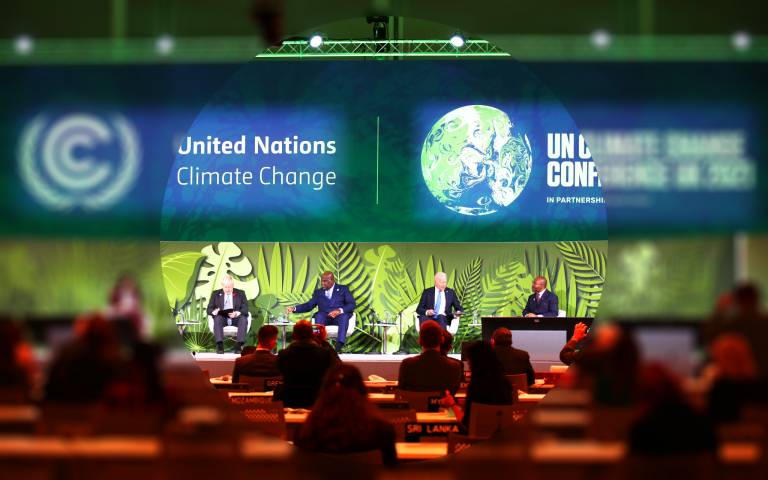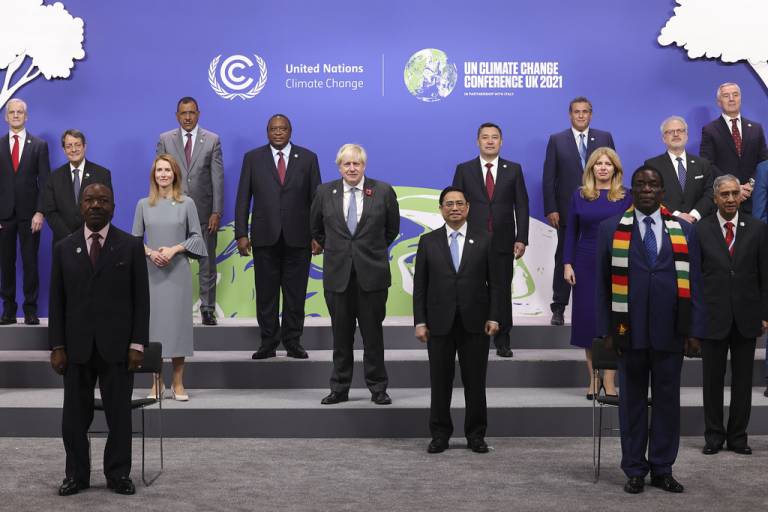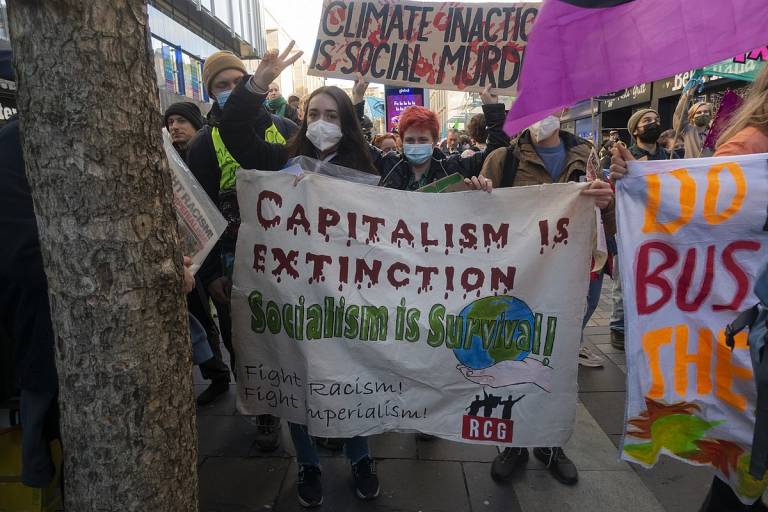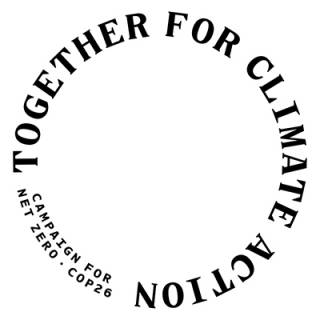COP26 – what happened, and where next?
29 November 2021

Introduction - as the dust settles
COP26 finally ended in Glasgow a day later than scheduled, on the 13th November 2021, with the conference’s President Alok Sharma declaring, “we can now say with credibility that we have kept 1.5 degrees alive. But, its pulse is weak and it will only survive if we keep our promises and translate commitments into rapid action.”
 A formal photograph at Day Two of the COP26 World Leaders Summit. Source: Number 10 on flickr
A formal photograph at Day Two of the COP26 World Leaders Summit. Source: Number 10 on flickr

Was Sharma right to claim this cautious victory, or are critics correct to brand it a failure? In this Explainer we reflect on what happened at COP26, how significant its agreements are in the fight against climate change, and what happens next.
COP26, as its name suggests, was the 26th meeting of the Conference of Parties to the UN Framework Convention on Climate Change (UNFCCC), established in 1992. In an earlier Explainer in this series we acknowledged the “justifiable frustration and anger at the slow pace of action” in the three decades since. However, we argued that “the political complexity of achieving a global climate change agreement is also a fact. And though the pace is frustratingly slow, the political achievements are real.”
We recalled that a significant change in approach, seeded in Copenhagen in 2009, and codified in the Paris Agreement of 2015, was to move away from a process focused on signing countries up to ‘top-down’ legally binding emissions targets, and towards a system of targets and pledges defined ‘bottom-up’ by countries themselves – the so-called “Nationally Determined Contributions” or NDCs. The NDCs would then be subject to an iterative ‘pledge, review and ratchet’ process that would over time see countries moving collectively towards emissions commensurate with “well below two degrees” temperature rise by the end of the 21st century. We described this as “a kind of hopeful alchemy… a commitment to start moving forward, even with very small pledges, in the belief that the movement itself will generate larger pledges further on.”
This approach is a gamble born of necessity. It makes a bet that it is preferable to have a voluntary process with wide global engagement, over a stringent top-down approach, to which only a few nations will feel able and willing to sign up.
It is important to examine critically the outputs of COP26 to see whether this gamble is paying off. There is plenty to criticise in the various agreements and pledges to emerge from the two weeks of COP26, and it is beyond question that much further progress is needed to maintain the possibility of holding the average global temperature rise to below 2°C, and particularly the more ambitious target of 1.5°C.
However, it is important to set such criticisms in context by considering in each case what the alternative would be. In a choice between an imperfect agreement, which nonetheless delivers some progress and has wide assent, and an agreement to which only a few nations can sign up, we believe that the former is preferable. It is also important to remember that these negotiations will continue for years to come, and their outcomes – and those of the increasing number of parallel processes - will continually evolve.
With this context in mind, in what follows we attempt to lay out the key developments and outcomes from COP26, and offer an assessment of how they measure up to what is needed.
What was achieved at COP26?
COP26 produced The Glasgow Pact – a final ‘cover text’ or ‘political decision’, negotiated and agreed between all parties. A number of other official documents provide further detail on particular aspects. The COP also served as a stage for various other announcements, pledges and initiatives from countries acting unilaterally or in groups. In what follows we examine what we believe to be the most important of such developments and outcomes.
National emissions pledges
In 2020, UNEP estimated that countries’ commitments to emissions reduction by 2030 – the NDCs – submitted up to that point, if implemented, would put the world on track for a temperature rise of 3°C. Under the terms of the Paris Agreement, COP26 marked the end of the first five-year ‘pledge, review and ratchet’ cycle. It was therefore a critical moment to see if the updated pledges would collectively be sufficient to keep the world on track for limiting temperature rise to 1.5°C, which requires global GHG emissions to reach net-zero by around 2050.
In the run up to the COP a number of countries announced new long-term net-zero targets. For example, in September both China and Saudi Arabia set net-zero targets for the year 2060. And during the Leaders’ Summit at COP26 Narendra Modi announced that India would seek carbon neutrality by 2070, as well as tightening targets for 2030. However, these targets have not been formally submitted to the UN, with Modi indicating that they would be dependent on developed nations providing $1tn in climate finance.
Nonetheless, as a result of these and other announcements, countries in which net-zero targets have either been enacted or are under discussion now account for 90% of global emissions. By October 2021, the IEA calculated that revised NDCs and growing net-zero targets could bring the trajectory down to 2.1°C. And the IEA’s most recent assessment in early November, which took into account further pledges up to and including the first week of COP, suggested that if all such pledges were implemented in full and on time, the temperature rise would be held to 1.8°C by the end of the century. Other assessments however are not quite so optimistic, Climate Action Tracker projecting a value of 2.1°C if all current pledges and binding long-term targets are achieved.
The coming decade will be crucial in determining whether we will achieve, or even come close to achieving, 1.5°C in the long-run. The Glasgow Pact explicitly “recognizes that limiting global warming to 1.5 °C requires… reducing global carbon dioxide emissions by 45 per cent by 2030 relative to the 2010 level.” While longer-term ambition is welcome, the crux of the problem remains the lack of ambition in short-term targets and associated concrete commitment - through appropriate policy actions - to achieving them.
The Glasgow Pact “requests” countries to “revisit and strengthen” their targets by the end of 2022 in order to bring them into line with “the Paris Agreement temperature goal.” The Pact also establishes an “annual high-level ministerial round table on pre-2030 ambition,” to begin from COP27. Compared to the five-yearly timescale of successive ‘pledge, review and ratchet’ rounds envisaged in 2015 in the Paris Agreement, such a call to increase ambition in just 12 months’ time could be seen as clear recognition of this deficiency. The degree to which these mechanisms engender increased international ambition, and action to match, remains to be seen.
Emissions trading
The principle of trading emissions has been present in international climate negotiations dating back to 1997’s Kyoto Protocol – though it is a complex and contested area.
The principle is that as greenhouse gases are global rather than local pollutants, it should not matter exactly where any particular quantity of greenhouse gas is avoided. If taking measures to reduce emissions is cheaper in one country than another, then the latter can pay for the emissions reductions in the former and count them towards achievement of its target. In doing so, global emissions can be reduced at a lower overall cost.
Under the Kyoto Protocol, mechanisms were established to allow such emissions trading between countries. Activities that qualified for generating credits included building low-carbon power stations and measures that reduced emissions caused by deforestation. Projects had to prove ‘additionality’ – i.e. they were producing genuine emissions reductions that would not otherwise have occurred; and ‘sustainability’ – i.e. other environmental or social harms did not result. However, reviews of projects actually carried out under such mechanisms have shown that monitoring, verifying and ensuring such conditions is far from straightforward.
In a world aiming for net-zero, rapidly growing demand for ‘negative emissions’ from large-scale planting of crops and trees may occur. For some countries with large land areas, such as Brazil, such demand could be particularly lucrative. However, monitoring and verifying additionality and sustainability of land-based negative emissions projects – where wider social and environmental impacts are a substantial risk – is particularly difficult.
A section of the Paris Agreement – Article 6 – placed a bookmark for the development of a new, global country-to-country emissions trading system. Another item on the agenda of COP26 was to establish the “rulebook” for this system.
COP26 produced documents which set out some basic principles for avoiding ‘double counting’, which would arise if both the country funding the measure and the country hosting it were to claim the same reduced emissions as their own. Essentially, if the emissions reduction is claimed by the purchaser of the emissions, it must not be included in the accounts of the host country.
The COP also introduced some complexity into the system by effectively setting up a tax on emissions traded through this mechanism in order to help fund adaptation measures. This was pushed for in particular by African nations, concerned that sufficient funding for adaptation was not forthcoming through other channels – indicating the interrelatedness of the various strands of negotiation.
Potential loopholes in the system remain, including the allowance of some credits generated under the Kyoto mechanisms into the new system, leading some commentators to caution that potential buyers of such credits will need to research the sustainability and additionality of what they are buying.
However, these proposals focus almost entirely on the market structures and accounting mechanisms of trading. Given the huge risks of negative sustainability impacts and failed emissions reductions of the kinds of large scale land-based projects that could be funded through emissions trading, a robust, transparent and globally consistent monitoring and verification system must be developed as a priority, if the system is to be used successfully.
Leaders’ Declaration on Forests and Land Use
In the opening days of COP26, 141 leaders signed a Declaration on Forests and Land Use in which they “commit to working collectively to halt and reverse forest loss and land degradation by 2030.” However, representatives of Indonesia, which had signed up to the declaration, later stated that they did not interpret it as a commitment to “end deforestation.” In any case, the ending or even slowing of deforestation will not be delivered by this declaration alone, but will be dependent on rigorous measures, monitoring and enforcement within individual countries. The Declaration refers to various sources of funding to help achieve this goal, totalling about $20bn.
The Global Methane Pledge
Over 100 countries, in signing the “Global Methane Pledge”, committed to “a collective goal of reducing global methane emissions by at least 30 percent from 2020 levels by 2030.” The Pledge estimates that the effect of this reduction would be to “reduce warming by at least 0.2 degrees Celsius by 2050.” Again, critics could find much that is unsatisfactory about the pledge. A “commitment” to a “goal” could be read as simply a promise to try. The Pledge itself is unspecific, the quantities of money mentioned are relatively small, and important methane emitters including China, India, Australia and Russia, have not signed. But, as methane – a relatively short-lived but potent greenhouse gas – had been largely absent from discussions at the global level, this Pledge represents a clear and positive step forward.
Climate finance, funding, loss and damage
In the Copenhagen Accord in 2009 developed countries pledged to provide climate finance of $100 bn per year by 2020, to help emerging economies to decarbonise and adapt to climate change. However, it is unlikely this goal will be met until 2023. The failure to reach this target on time is indicative of a wider failure of the global community to face up seriously to the issue of supporting those developing countries most affected by climate change. The Glasgow Pact “urges” the community to reach this target as soon as possible, and to “at least double their collective provision of climate finance for adaptation from 2019 levels by 2025.”
The Pact also highlights the issue of “loss and damage”, referring to the actual impacts of climate change to which the world is currently committed. Although it was included in the Paris Agreement, this phrase has been considered contentious by some of the predominantly richer nations which are responsible for the vast majority of cumulative GHG emissions, for fear it could be interpreted as indicating liability and result in claims for compensation. Whilst the text “reiterates the urgency of scaling up action and support”, it does not add significantly to already existing mechanisms, or set out more detailed principles, for responding to loss and damage. Most critically, and to the bitter disappointment of countries vulnerable to the impacts of climate change, it does not put any real money on the table (although Scotland received plaudits for pledging £2m). Instead, the Glasgow Dialogue is established, but only to “discuss the arrangements for the funding of activities to avert, minimise and address loss and damage associated with the adverse impacts of climate change.”
The issue of relative responsibility for climate change has haunted climate negotiations since their inception. It remains a simple fact that some nations bear more responsibility for historic greenhouse gas emissions; and another simple fact that some countries are richer than others. The issue of finance was trailed heavily by the UK Presidency, and during the conference the Glasgow Financial Alliance for Net-Zero (GFANZ), claimed that $130tn were available for investment in the net-zero transition – although these trillions were merely the collective asset base of the institutions involved, not cash ready to roll.
But even the term ‘climate finance’ is itself subject to ambiguities – which richer countries have been somewhat resistant to clarifying – as to whether it involves grants or loans, or public or private sector investments. Unless richer countries show more leadership in facing up to the global inequalities, both in impacts and responsibilities, with which climate change is suffused, and in mobilising serious flows of cash in acknowledgement of these inequalities, many developing countries will continue to resist the emissions reductions required by the Paris Agreement temperature targets.
Dethroning 'King Coal'
A key priority of the UK presidency at COP26 was to achieve commitments to accelerate the phase out of coal-fired electricity. Coal, when burned, is the most CO2-intensive fossil fuel. Early drafts of the Glasgow Pact called for a “phasing-out of coal”, but this was revised to the more ambiguous “phase-down of unabated coal power” (our italics), following a last-minute negotiation initiated by Indian environment minister Bhupender Yadav, supported by the Chinese delegation.
The Pact was however able to call for another kind of “phase-out” – of “inefficient fossil fuel subsidies.” Economically speaking, all fossil fuel subsidies are inefficient, but such language, first introduced at meetings of the G20 group of countries some time ago, enables some countries to argue that, from a non-economic perspective, their fossil subsidies are not “inefficient.”
Civil society
Several of the COP documents speak approvingly of the role of a broad range of stakeholders, including local and regional governments, cultural institutions, NGOs, youth, women, indigenous people, and others. The Glasgow Work Programme on Action for Climate Empowerment aims to offer a flexible framework for the support of the activities of such broader stakeholders.
The Work Programme is low on detail; and moreover it is not especially clear that many elements of civil society needed or were waiting for the kind of generic approval the document offers. The wide and passionate civil society engagement in COP26 and with climate issues more broadly, a sample of which was present outside the conference venues, provides a striking contrast to the familiar scenes of huddles of suited diplomats haggling over phraseology in a cavernous conference hall.
 Climate demonstrations in Glasgow, November 2021. Source: wikimedia
Climate demonstrations in Glasgow, November 2021. Source: wikimedia

At the same time it has been estimated that around 500 lobbyists for the fossil fuel industry gained access to the talks.
A more ambitious agenda would seek to explore ways of more formally incorporating civil society perspectives within the process.
So, was it a success?
Evidently, COP26 was not an unmitigated success. National pledges do not yet put us on track for 1.5°C; and the pledges made at COP26 must be delivered through robust and strategic action within the countries themselves. In the areas of funding and financing of climate mitigation, adaptation and redress of loss and damage, the major historical polluters of the world are still not fully facing up to their responsibilities. Pledges on deforestation, methane and coal remain either vague, watered down, or do not engage key players. There is more work to do to ensure that international emissions trading does not become greenwash.
And yet, notwithstanding their shortcomings, the developments described above represent progress, and the rapid journey of the collective national pledges from a world of 3°C to a world of around 2°C or a little below, has demonstrated reasons to keep faith with the bottom-up approach adopted by the Paris Agreement. All we can do is keep moving forward, tightening up targets, filling gaps, combing out contradictions.
Where next?
COP27 will take place in 2022 at Sharm-El-Sheikh in Egypt. The Glasgow Pact’s call for nations to revisit and strengthen their pledges in the coming year has heightened its significance.
What are the chances that greater ambition will be forthcoming? This depends on what progress can be made within and across different countries in different dimensions, with regard to technology, money and politics, in particular. Ambitious and effective leadership at the country level will be crucial. Such leadership will require those who understand what is needed, and the courage to pursue it, through a coherent and inclusive strategy for transformational change. Leadership is shown by those who embrace the challenge of going further and faster than the grudging minimum.
There are many justifications for feeling sceptical about the process and its pledges. The sloganeering and spin; the deep contradictions between stated intentions and domestic policies, including ongoing support for fossil fuel investments; the failure to meet modest financing targets for developing economies; the reluctance to face up to historic responsibilities and consider even minimal redress.
But leadership can occur at multiple levels. While international processes embodied by the annual COP are important, what has also become clear is the important role of other governance levels, of the private sector and of civil society. By continuing to face up to internal contradictions and taking whatever action we can at whatever level we can, we can continue to change the context such that at future COPs leaders will find it increasingly impossible to resist the inexorable logic of decarbonisation.
For further discussions of COP26 and its outcomes, from contrasting perspectives, please see:
- COP26 – so was that it? - Dieter Helm
- What Happened in Glasgow at COP26? - Robert Stavins
 Close
Close


